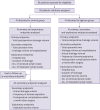A Prospective Randomized Study to Compare Postoperative Drainage After Mastectomy Using Electrosurgical Bipolar Systems and Conventional Electro-Cautery
- PMID: 35914746
- PMCID: PMC9411027
- DOI: 10.4048/jbc.2022.25.e29
A Prospective Randomized Study to Compare Postoperative Drainage After Mastectomy Using Electrosurgical Bipolar Systems and Conventional Electro-Cautery
Abstract
Purpose: Advanced energy devices, including electrosurgical bipolar systems or ultrasonic shears, are widely used in various surgeries. An electrosurgical bipolar device allows surgeons to grasp and dissect tissues, as well as simultaneously ligate and cut vessels and lymphatics during surgery. This study aimed to evaluate the effects of advanced bipolar energy devices on the reduction in seroma formation during mastectomy, axillary staging, and/or reconstruction.
Methods: This prospective randomized clinical trial with a 1:1 ratio compared the use of an electrosurgical bipolar device, LigaSureTM (LGS), against conventional cut-and-ligate techniques in mastectomy with axillary procedures for patients with breast cancer. A total of 82 patients with breast cancer who underwent definitive surgery were enrolled in this study. The primary endpoint was the total drainage volume after surgery.
Results: The clinicopathological characteristics of the two groups were not significantly different. The total postoperative drainage volume was significantly lower in the LGS group than in the control group (756.26 mL vs. 1,167.74 mL, p = 0.009). The actual postoperative drainage volume and duration also decreased significantly in the LGS group compared with those in the control group (all p < 0.05). The rate of postoperative complications was lower in the LGS group than in the control group (9.8% vs. 27.5%, p = 0.05).
Conclusion: Electrosurgical bipolar devices showed better performance in terms of decreasing postoperative drainage during mastectomy and axillary staging and/or reconstruction.
Keywords: Breast Neoplasms; Postoperative Complications; Seroma; Surgical Procedures, Operative.
© 2022 Korean Breast Cancer Society.
Conflict of interest statement
This study was supported by Medtronic. The funding source was not involved in the study design, data collection, analyses, and manuscript writing. The funding was distributed: salary, support of authors, study coordinator, resident, fellow, statistician, secretary, or other; laboratory analyses/equipment; devices, medications or materials; and administration duties.
Figures




Similar articles
-
Advanced hemostasis in axillary lymph node dissection for locally advanced breast cancer: new technology devices compared in the prevention of seroma formation.BMC Surg. 2019 Apr 24;18(Suppl 1):125. doi: 10.1186/s12893-018-0454-8. BMC Surg. 2019. PMID: 31074399 Free PMC article.
-
Outcomes of the Electrothermal Bipolar Vessel Sealing Device and Electrocautery in Modified Radical Mastectomy Patients.Cureus. 2024 Jun 14;16(6):e62371. doi: 10.7759/cureus.62371. eCollection 2024 Jun. Cureus. 2024. PMID: 39006716 Free PMC article.
-
Impact of the surgical modality for axillary lymph node dissection on postoperative drainage and seroma formation after total mastectomy.Patient Saf Surg. 2019 May 14;13:20. doi: 10.1186/s13037-019-0199-z. eCollection 2019. Patient Saf Surg. 2019. PMID: 31114633 Free PMC article.
-
Impact of Quilting Sutures on Surgical Outcomes After Mastectomy: A Systematic Review and Meta-Analysis.Ann Surg Oncol. 2022 Jun;29(6):3785-3797. doi: 10.1245/s10434-022-11350-5. Epub 2022 Feb 1. Ann Surg Oncol. 2022. PMID: 35103890
-
A systematic review and meta-analysis of Harmonic technology compared with conventional techniques in mastectomy and breast-conserving surgery with lymphadenectomy for breast cancer.Breast Cancer (Dove Med Press). 2016 Jul 18;8:125-40. doi: 10.2147/BCTT.S110461. eCollection 2016. Breast Cancer (Dove Med Press). 2016. PMID: 27486342 Free PMC article. Review.
Cited by
-
Total Sealing Technique (TST) with a bipolar vessel sealing system reduces lymphorrhea and seroma formation for axillary lymph node dissection in primary breast cancer.Surg Open Sci. 2024 Jan 23;19:1-7. doi: 10.1016/j.sopen.2024.01.011. eCollection 2024 Jun. Surg Open Sci. 2024. PMID: 38590584 Free PMC article.
-
Efficacy and safety of surgical energy devices for axillary node dissection: a systematic review and network meta-analysis.Breast Cancer. 2023 Jul;30(4):531-540. doi: 10.1007/s12282-023-01460-7. Epub 2023 Apr 14. Breast Cancer. 2023. PMID: 37058224
-
Monopolar diathermy versus a vessel-sealing device for reducing postoperative drain output after simple mastectomy: randomized clinical trial.Br J Surg. 2024 Mar 2;111(3):znae029. doi: 10.1093/bjs/znae029. Br J Surg. 2024. PMID: 38498075 Free PMC article. Clinical Trial.
-
A Retrospective Study of Transaxillary Endoscopic Breast Augmentation Using Ultrasonic Scalpel or Conventional Electrocautery for Implant Pocket Dissection.Aesthetic Plast Surg. 2024 May;48(10):1949-1955. doi: 10.1007/s00266-023-03569-8. Epub 2023 Aug 25. Aesthetic Plast Surg. 2024. PMID: 37626139
-
The effectiveness of different flap-raising techniques for mastectomy in reducing the rate of complications: a network meta-analysis.BMC Surg. 2024 Dec 23;24(1):415. doi: 10.1186/s12893-024-02723-6. BMC Surg. 2024. PMID: 39716134 Free PMC article.
References
-
- van Bemmel AJ, van de Velde CJ, Schmitz RF, Liefers GJ. Prevention of seroma formation after axillary dissection in breast cancer: a systematic review. Eur J Surg Oncol. 2011;37:829–835. - PubMed
-
- Manouras A, Markogiannakis H, Genetzakis M, Filippakis GM, Lagoudianakis EE, Kafiri G, et al. Modified radical mastectomy with axillary dissection using the electrothermal bipolar vessel sealing system. Arch Surg. 2008;143:575–580. - PubMed
-
- Nespoli L, Antolini L, Stucchi C, Nespoli A, Valsecchi MG, Gianotti L. Axillary lymphadenectomy for breast cancer. A randomized controlled trial comparing a bipolar vessel sealing system to the conventional technique. Breast. 2012;21:739–745. - PubMed
-
- Cortadellas T, Córdoba O, Espinosa-Bravo M, Mendoza-Santin C, Rodríguez-Fernández J, Esgueva A, et al. Electrothermal bipolar vessel sealing system in axillary dissection: a prospective randomized clinical study. Int J Surg. 2011;9:636–640. - PubMed
-
- Lumachi F, Brandes AA, Burelli P, Basso SM, Iacobone M, Ermani M. Seroma prevention following axillary dissection in patients with breast cancer by using ultrasound scissors: a prospective clinical study. Eur J Surg Oncol. 2004;30:526–530. - PubMed
Grants and funding
LinkOut - more resources
Full Text Sources
Medical

